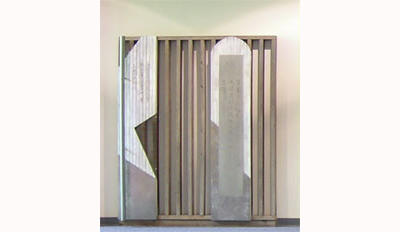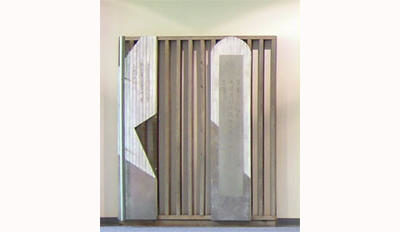Bridge to Angel Island
Richard Turner
Bridge to Angel Island is a temporary installation commissioned from the juried proposals submitted for the 1985 UAM exhibition, Monuments To… In 1882, the United States Government passed the Chinese Exclusionary Act, a law designed to thwart Asian immigration. After its passage, Chinese arrivals to the West Coast were detained on Angel Island in San Francisco Bay. The artist expressed his sympathy for the plight of these immigrants with the layered, monolithic panels and the monochromatic surface. Bridge to Angel Island is composed of tombstone−like panels of glass, steel, and wood—materials similar to those of the Angel Island barracks. Etched, carved, and sandblasted calligraphy reveals poems written by the Chinese detainees that speak eloquently of the hopeless situation of the victims. These five poems of frustration, grief and devastation, speak eloquently of the death of dreams and hope, and of the victims’ helplessness. Linked together, they form a linear anthology that is meant to be read, first as a monument to one injustice and then to all injustices past, present and future. Born in Kansas City, Missouri, Turner is the son of an American who was stationed in Saigon to advise the Vietnamese police on American police tactics. Turner spent his adolescence in Vietnam before the U.S. involvement in the war, graduating from high school in Saigon in 1961. Subsequently, he resided in other Southeast Asian countries. He graduated from Antioch College in 1967, received an M.F.A. from University of Michigan in 1970, and teaches at Chapman College. In his work he sometimes uses metaphors that mix aspects of Eastern and Western culture.
GET DIRECTIONS »



